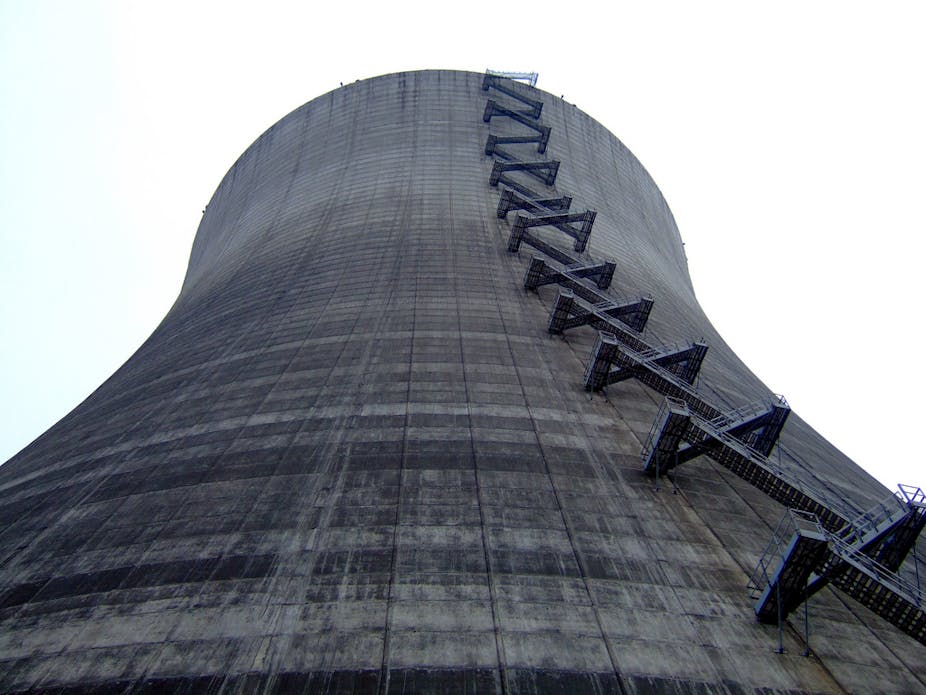As the world grapples with the competing imperatives of the tragic fallout from the Fukushima meltdown, and the urgent need to reduce greenhouse gas emissions, some are turning to new forms of nuclear power to meet our energy needs.
One of the posited solutions to this crisis is the use of thorium, rather than uranium, as a fuel for nuclear reactors.
But can thorium make nuclear power more politically palatable? And how does it differ from uranium?
What is thorium?
To inject some clarity into discussions about thorium, we have to talk about isotopes.
Thorium has only one isotope in nature, thorium-232. Formally it is equivalent to the isotope uranium-238, or “depleted uranium”.
Thorium-232 is not a fissile material. You can’t start off with it as the primary material in a reactor.
Uranium-235 is called fissile because it splits into two (fissions) when it captures a neutron, releasing a large amount of energy. Thorium-232 doesn’t.
In contrast, uranium-238 and thorium-232 are what is called “fertile”.
Thorium-232 must be made into thorium-233, which eventually leads through decay to the fissile isotope uranium-233, in the same way that plutonium-239 is produced from uranium-238.
Whether you use a conventional thermal reactor, or a molten-salt thermal reactor, or a fast breeder/burner reactor, or a sub-critical, accelerator driven system, the sequence would involve breeding and perhaps re-processing to extract the fissile material for re-use.
This is a more elaborate process than the normal once-through cycle.
There are several possible advantages to using thorium in nuclear energy.
Sidestepping Dr Strangelove
By breeding thorium, we can avoid making plutonium-239, which is used in nuclear weapons.
Instead, the use of thorium produces uranium-233, which is perceived to be less “attractive” for weapons mainly because some by-products (uranium-232 in particular) produce radiation which would make it more difficult to handle.
Realistically, it’s hard to tell how serious a deterrent such a radiological issue would really be to a determined bandit, or a nation that wouldn’t shy away from sacrificing a few workers.
Watching your waste
The second advantage is the constitution of the waste.
Because the process starts off with a lighter nucleus (thorium has 90 protons but uranium has 92), fewer of the heavier element by-products are made. These constitute a significant part of very long-lived waste.
It is also the case that uranium-233 is a slightly better reactor fuel than either uranium-235 or plutonium-239 and the only one that could be used in a “thermal breeder rather than a ”fast breeder“.
Making a "thermal breeder” is a technical challenge. India’s government intended to build one when it planned the move to nuclear power (and a full nuclear fuel cycle) back in the early 1950s, the idea being that they would eventually be able to use their thorium resources, in the absence of indigenous uranium.
The country’s current plans include thorium but now in the context of a fast breeder system.
No silver bullet
Some of the rhetoric associated with thorium gives the impression that thorium is, somehow, magical.
In reality it isn’t.
The primary fuels would involve fissile material, including in some proposals, thorium mixed with highly-enriched (ex-weapons) plutonium-239.
We are nevertheless used to regular pronouncements about thorium. One of the more recent resulted in an article in the Canberra Times in April this year.
This article contained the particularly silly claim (often seen in some form) that: “Almost all the (thorium) mineral is usable as fuel compared to 0.7% of uranium. There is enough to power civilisation for millennia.”
In fact, in that sense, none of the thorium is usable since it is not fissile. The comparison should be with the analogous fertile isotope uranium-238, which makes up nearly 100% of natural uranium.
If you wanted to go that way (breeding that is), there is already enough uranium-238 to “power civilization for millennia”.
Thorium has advantages – particularly its lower suitability for building weapons, and its less-toxic waste – but perhaps not always those that are claimed.

